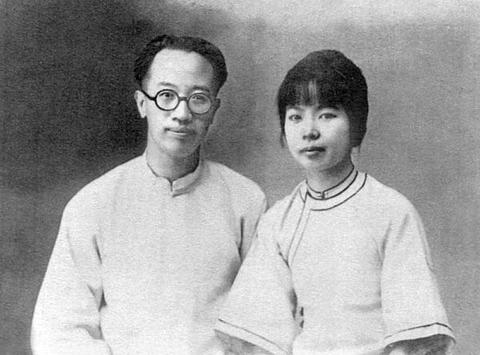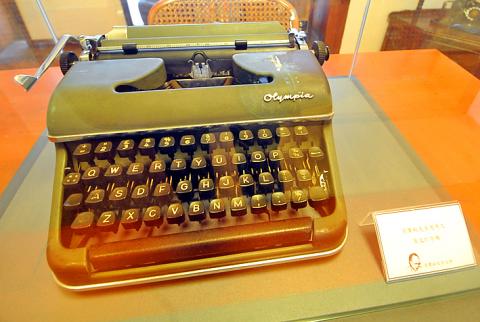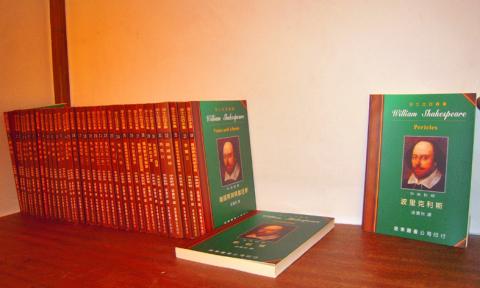Taiwan in Time: Nov. 2 to Nov. 8
Upon the mention of Shakespeare during an interview in 1987, an 84-year-old Liang Shih-chiu (梁實秋) exclaimed, “Shakespeare again! I’ve already declared that I’ve severed all relations with him.”
But the Chinese-born writer and longtime National Taiwan Normal University (國立師範大學) English professor seemed eager to discuss what he called the “most important task in his life” — translating into Chinese the entire works of the legendary playwright and poet.

Courtesy of Wikipedia Commons
Liang died on Nov. 3 in Taipei, just a few months after that interview.
When the project was conceived in 1930, Liang was a young scholar who had recently returned to China after studying literature at Harvard and Columbia universities. It was 1967 when he singlehandedly completed the momentous task, and by that time he was a retired professor living in Taiwan.
The finished product contained 40 volumes (37 plays and three poem collections) and more than four million words. During the celebratory feast, Liang listed three key traits a person would need to accomplish what he did.

Photo: Wang Min-wei, Taipei Times
“Firstly, he can’t be too academically inclined, because if so, he would be doing research instead. Secondly, he can’t be a genius, because if so, he would be creating his own works instead. Thirdly, he must be long-living. I’m lucky that I possess all three traits,” he is reported to have said.
It wasn’t supposed to take this long. Philosopher and writer Hu Shih (胡適), then on the translation committee of the China Foundation for the Promotion of Education Culture (中華文化教育基金會), had planned for it to be a group project between five scholars, to be completed in five years.
Liang wrote that the other four dropped out for various reasons, and he carried on alone. However, war soon broke out in China with the Japanese invasion and later the Chinese Civil War. The majority of the translation was done in Taiwan, to where Liang had retreated with the Chinese Nationalist Party in 1949.

Photo: Hu Ching-hui, Taipei Times
Liang already had a few English-language book translations — Peter Pan and Silas Marner — under his belt when Hu recruited him.
Born in Beijing in 1903, Liang attended Tsinghua School (清華學校), which back then was a western-style prep school for students to study abroad in the US. In 1923, the entire class headed to the US, where Liang would spend time at Colorado College, Harvard and Columbia University. However, he was just as passionate about Chinese literature as he was Western.
He was very particular about his translation work, stating that his primary concern was to stay true to the original meaning of the text instead of translating directly. The main difference is that Liang’s translation is meant to be read, while Shakespeare’s works are meant to be acted out on a stage.
“Although I can’t translate word for word, at least I tried to do it sentence by sentence,” he said. “I will absolutely not delete anything, unlike some people today. I even tried to keep Shakespeare’s punctuation.”
It’s often mentioned how Liang also kept all obscene language or sexual references, which was not commonplace in those times.
“Sex is something that everyone is interested in, even in Chinese theater,” he said.
He also mentions the difficulty of translating puns.
“It’s just wordplay and doesn’t have much actual significance,” he says. “But the audience at that time enjoyed the puns. Occasionally, they can be translated into Chinese, but most of the time I can only explain them in the footnotes.”
Hu promised to personally throw a huge banquet for Liang, but he never got the chance because Wu died five years before the books were completed. After Liang finished translating all of Shakespeare’s plays, a banquet was held in Taipei on Aug. 6, 1967 with more than 300 people attending. But he wasn’t satisfied yet, and spent another year translating the playwright’s poetry.
Liang’s love affair with British literature didn’t stop there. In 1972, he embarked on another gargantuan project that kept him busy for the next seven years: History of British Literature (英國文學史) and Anthology of British Literature (英國文學選). Both works contain over one million words.
Taiwan in Time, a column about Taiwan’s history that is published every Sunday, spotlights important or interesting events around the nation that have anniversaries this week.

Exceptions to the rule are sometimes revealing. For a brief few years, there was an emerging ideological split between the Democratic Progressive Party (DPP) and Chinese Nationalist Party (KMT) that appeared to be pushing the DPP in a direction that would be considered more liberal, and the KMT more conservative. In the previous column, “The KMT-DPP’s bureaucrat-led developmental state” (Dec. 11, page 12), we examined how Taiwan’s democratic system developed, and how both the two main parties largely accepted a similar consensus on how Taiwan should be run domestically and did not split along the left-right lines more familiar in

As I finally slid into the warm embrace of the hot, clifftop pool, it was a serene moment of reflection. The sound of the river reflected off the cave walls, the white of our camping lights reflected off the dark, shimmering surface of the water, and I reflected on how fortunate I was to be here. After all, the beautiful walk through narrow canyons that had brought us here had been inaccessible for five years — and will be again soon. The day had started at the Huisun Forest Area (惠蓀林場), at the end of Nantou County Route 80, north and east

Specialty sandwiches loaded with the contents of an entire charcuterie board, overflowing with sauces, creams and all manner of creative add-ons, is perhaps one of the biggest global food trends of this year. From London to New York, lines form down the block for mortadella, burrata, pistachio and more stuffed between slices of fresh sourdough, rye or focaccia. To try the trend in Taipei, Munchies Mafia is for sure the spot — could this be the best sandwich in town? Carlos from Spain and Sergio from Mexico opened this spot just seven months ago. The two met working in the

This month the government ordered a one-year block of Xiaohongshu (小紅書) or Rednote, a Chinese social media platform with more than 3 million users in Taiwan. The government pointed to widespread fraud activity on the platform, along with cybersecurity failures. Officials said that they had reached out to the company and asked it to change. However, they received no response. The pro-China parties, the Chinese Nationalist Party (KMT) and Taiwan People’s Party (TPP), immediately swung into action, denouncing the ban as an attack on free speech. This “free speech” claim was then echoed by the People’s Republic of China (PRC),